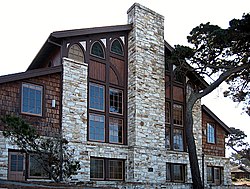Craftsman architecture

Craftsman was a style of architecture in the United States in the early 20th century. It is called that because Gustav Stickley, a craftsman furniture maker, had a magazine called The Craftsman. The movement was part of the Arts and Crafts movement that started in England in the late 19th century. It wanted a "simpler way of life" that was not like American and English industrialized society. Architects such as Greene and Greene designed Craftsman homes such as the Gamble House. These houses were well-made, but did not have a lot of ornamentation. Often they played off of natural themes. A smaller version of the craftsman home was the bungalow. By the 1910s, Craftsman bungalows were being built in large numbers in and around American cities. Besides America and England, there was a lot of Craftsman architecture in Japan.
Craftsman Architecture Media
Merrill Hall at the Asilomar Conference Grounds in Pacific Grove, California, a Julia Morgan design completed in 1928
The Gamble House, an iconic American Arts and Crafts design by Greene & Greene in Pasadena, California, built between 1908 and 1909
Facade of the Castle in the Clouds and lawn overlooking Lake Winnipesaukee in New Hampshire, built 1913–1914
The Edward Schulmerich House in Hillsboro, Oregon, completed in 1915
The Abernathy-Shaw House in the Silk Stocking District of Talladega, Alabama, built in 1908
F.E. Cottrell Apartment Building in the Old West End District of Toledo, Ohio, built 1914–1915
Esplanade Apartments, 3015 North Pennsylvania Street, 1998 in Indianapolis, Indiana, built in 1912






